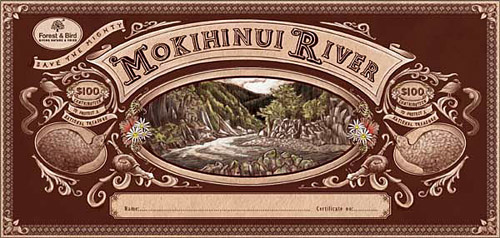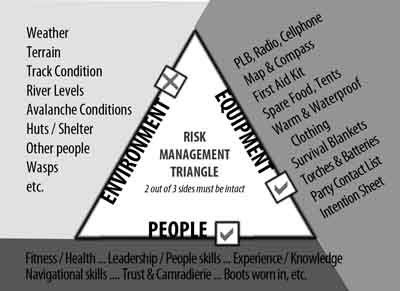Newsletter, May 2011
CONTENTS >
- Lawrie's Bucket List Tramp > South Coast Track, Fiordland
- Member Profile > Jo Kay
- Club Nights > Add to your 2011 calendar
- BANFF Film Festival > Advert
- MSC Courses > Bushcraft & First Aid
- Kahurangi ByLAWS > What do YOU think?
- FMC Campaign > Save the Mokihinui River
- Risk Management, Part 1 > Theory to assist decision-making
Download the printed version of the newsletter (8 pages, more photos) as a 0.8-megabyte PDF file. (You will need Adobe Acrobat Reader or similar program installed on your computer. Broadband connection preferable.)
PRESIDENT'S COMMENT > Bucket List Adventure...

Father & son tackle the South Coast Track, Fiordland
When I got an invitation from family to explore the southern Fiordland coast, especially as it was rising up the batting order of bucket list activities, then I was off like a shot.
A couple of weeks ago I joined my son Brett in Invercargill then from Tuatapere we helicoptered into Lake Hakapoa and Big River in south-west Fiordland National Park. Being a forester by profession I have heard much through the years about the wonderful pristine podocarp forest of this region and have always wanted to see it for myself.
The first night we stayed in Westies, a private hut and magical place, nestled under a huge arch of coastal rock and only 40 metres from the pounding surf.
As we hiked eastward towards the road end at Blue Cliffs Beach we traversed some amazing bush; coastal hardwood scrub and mighty southern rata and a little further inland, the mighty rimu. It was simply amazing to walk through the maze of these towering giants – for a forester, at least this was a spiritual experience.
Once we crossed the Waitutu River, then the Wairaurahiri River, the virgin forest gave way to twelve kilometres of logged over-forest and the famous Port Craig bush tramway.
The logging in this isolated spot began in 1918 and was thankfully stopped in 1928 as the world-wide Depression began to bite. Interestingly enough, the loggers came from the upper South Island, being the Marlborough Timber Company (the Resse family), that had logged podocarps between Havelock and Pelorous Bridge.
The settlement of Port Craig, or more accurately the remnants thereof, had a real feel of yesteryear. All that’s left of this once thriving community of 200 people is the schoolhouse that now serves as a DOC hut, and scattered remains of an assortment of logging and sawmilling equipment.
In addition to the schoolhouse, still standing proud are the amazing Australian hardwood viaducts. The longest is the Percy Burn viaduct – a dazzling feat of engineering given the era in which these bridges were built.
Finally, hiking with a good mate was truly a treasured experience – which I’m sure is why many of us escape the pressures of our everyday lives – but in the process are enchanted and up-lifted by our backcountry experience.
Lawrie Halkett, President
1. Place of birth: Spud-land, Pukekohe.
2. Job: Relieving pharmacist, I only take on jobs that don’t interfere with my outdoor adventures, sort of semi retired really.
3. Been a member for: Nearly 4 years.
4. How I’ve benefited from NTC: Making those trips happen that I used to only dream about and finding new places to go and of COURSE the cool people and friends I’ve made.
5. My best trip: Mt Peanter with ‘Patient Pat’ Holland as the leader, my first time on snow with crampons, the sunny, cloudless day and views to die for. I was sooooo excited.
6. My worst trip: Failed attempt to Mt Cupola when a member of the party took a wrong turning, causing grave concern about her safety, and sabotaged the trip. Talk about anti climax. I was lucky enough to make it there earlier this year. This time it was one of my best trips.
7. My stupidest moment: Leaving my boots in the old Newmans bus depot when heading over to Marahau for my first trip to Abel Tasman. That was in the days when you didn’t have to book the huts. I had an old external frame pack with seat belt-webbing shoulder straps, and a woollen swanni. The wekas were abundant and I still looked good in short shorts.
9. My favourite tramping hut: Fenella Hut, at the head of the Cobb Valley. That hut has EVERYTHING: a loo with a view and a stained glass window, a fancy water feature for washing your hands just outside, all the cooking utensils you could ever need (I remember cooking up some tasty treats with Chef Alice) and a tin tub you can have a warm (sponge) bath in. Then just step outside and you’re surrounded by some pretty cool peaks.
10. What wild place would I put at the top of my ‘bucket list?’ I would love to do a mixed tramping/kayaking trip in Fiordland.
2011 CLUB NIGHTS > Put these dates in your diary.
7:30pm Nelson Intermediate School, Tipahi Street. Gold Coin.
- Monday 13 June > Silvano Lorandi > Italian Dolomites
- Monday 8 August 'AGM' > Martin Rodd, DOC officer & tramper
- Monday 3 October > TBA
- Monday 5 December 2011 > Annual Photo Competition
Saturday 21 May > BANFF Mountain Film Festival
Venue: Annesbrook Church, Stoke, Nelson
Duration: 2.5 hours
Tickets: Rollos & other stores.
Price: $25.00 (NZAC member: $15.00)
Contact: chrisshort@xtra.co.nz
MOUNTAIN SAFETY COUNCIL Nelson Courses
14 May > Bushcraft : River Safety
Cost: $25
Learning outcomes:
On completion, participants will:
- Be able to understand basic river dynamics and hazards.
- Know the safety rules for assessing whether it is safe to cross a river or stream.
- Know that it is often right to choose not to cross.
- Be able to pick where it is safest to cross.
- Be able to organise clothing and equipment for travel/river crossing.
- Be able to use an approved method for solo crossing (if alone).
- Be able to use an approved mutual support method.
- Know how to float & recover if swept away.
- Know how to self-release from a trapped pack.
- Know how to safely retreat during a crossing.
25–26 June > > Risk Management
Cost: $120
Risk management is a foundation skill for all outdoor leaders and those managing outdoor programmes. This course is training on:
- Risk management theory & principles
- Identifying, understanding and assessing risks and how to manage them
- Crisis management
- The practical application of the theory and principles of managing risk
13 August > Outdoor 1st Aid : Revalidation course
Cost: $85
Venue:
Girl Guide Centre, Paretai Lodge, Lee Valley Rd, Brightwater.
Duration:8 hours
The The course is skills-based, ‘hands on’, involving scenarios and practicals, aimed at updating the holder of a current OFA certificate with the recent changes in protocol and to refresh their skills. Skill erosion is a recognised factor that develops if a first aider is not exposed to actual first aid incidents.
All participants must have an OFA certificate which is dated no less than two years previous.
10-11 September > Outdoor 1st Aid :Full course
Cost: $150
Venue:
Girl Guide Centre, Paretai Lodge, Lee Valley Rd, Brightwater.
The Outdoor First Aid course is designed to equip outdoor users with the skills and knowledge necessary to manage accidents and sudden illnesses in the outdoor environment for a minimum of 24 hours.
You will complete a minimum of six hours practical work in the outdoors treating, in a group, people injured in mock accidents.
Contact: Evelyn O'Neill
Mail: 23 Coleridge Place, Stoke.
Telephone: (03) 547 2426.
Email: nelson@mountainsafety.org.nz
KAHURANGI NATIONAL PARK > Bylaws
In the FMC Bulletin of March 2010 (p17), we were alerted to some quite restrictive bylaws affecting our use of Kahurangi National Park.
Here is a brief summary...
- Groups of no more than 10 people cannot spend more than one night in the park.
- Tramping clubs need to be aware of the change, as do school groups and other outdoor education groups.
- No tramper can camp for more than 14 days, even in a different place every night. Those on a long back-country trip need to spend a night in a hut somewhere on route.
- No camping within 200 metres of a road is allowed, unless at a designated camping area. Tramping clubs often arrive at a road-end on Friday night, put up tents, then head off the next morning. This can no longer be done.
Your club committee wish to apply to the local DOC Conservator for an
exemption to these absurd laws. (The WM&TC did this with
success.)
> > > We need YOUR FEEDBACK.
Phone Pat Holland: 539 1340. E-mail: p.t.holland@xtra.co.nz
SAVE THE MOKIHINUI RIVER > Letter

Greetings to all Save the Mokihinui supporters! Thanks for your efforts over the past few weeks to pass on the message to Meridian that damming the Mokihinui is unacceptable. Over 2600 emails were sent. March 31 was the last date for sending an e-card.
How else can you help us win the battle? To assist with the Environment Court case, we have just launched our Save the Mokihinui shareholding campaign. You can purchase one of 140 limited edition shareholding certificates (featured above) of $100 each – securing your part in the battle to save the Mokihinui River.
Beautifully illustrated, the certificate encapsulates all that is valuable in the Mokihinui – from its enigmatic great spotted kiwi to its earthquake-shattered limestone gorges.
We hope this certificate will be an important piece of Mokihinui memorabilia in years to come as a reminder of battles won!
To buy your certificate and virtual plot click here:
http://www.savethemokihinui.org.nz/
Warm regards,
Debs Martin - 03-989-3355
Regional Field Officer, Top of the South
Royal Forest and Bird Protection Society of NZ Inc.
RISK MANAGEMENT THEORY > Part 1
by Raymond Salisbury
We had a tremendous, encouraging turnout at our recent ‘Chew The Fat’ evening. Our trip leaders and committee members mingled over free pizza, then discussed a range of issues regarding the organisation of tramping trips, and the management of people.
My contribution to this evening was a PowerPoint slideshow based on some excellent material from Mountain Safety Council.
Here, I have adapted their diagrams for our club. In the past I found this theory helpful in making critical planning decisions. For example, if the weather forecast was dodgy, should we still forge ahead with the planned tramp? Or, should I accept a complete stranger onto a hard trip?

1 > RISK MANAGEMENT TRIANGLE
The basic premise of this diagram, is that two out of the three sides must be ticked off.
In Figure 1 above, the tramping party have a good environment AND good people. So, if they forget some equipment, or if their equipment is not that good, it probably won’t matter.
For example, if the weather is great, the terrain is easy and the tracks are marked really well, there is a wider safety margin for error. This forgiving environment, combined with competent leadership and experienced decision-making should hopefully negate the use of the safety equipment.

In Figure 2, above, the tramping party have good equipment AND good people. They can, therefore, enter a tougher environment. This might equate to attempting a difficult route, or risking adverse weather. They have the back-up gear (like first aid kit, locator beacon, warm clothing, etc.) and they have the combined knowledge and experience to prevent, or at least cope with accidents.
Hopefully this theory is beneficial to you, or at least interesting.
| Attachment | Size |
|---|---|
| westieshut.jpg | 55.84 KB |
| banff_world_tour_240.png | 61.05 KB |
| risktriangle_1.jpg | 42.41 KB |
| risktriangle_2.jpg | 43.97 KB |
| ntc_nl_may2011_web.pdf | 795.93 KB |


